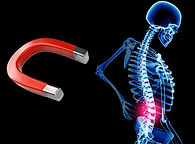

How does it work?
The established theory behind the use of magnetic fields as a healing method goes along the lines that the nerves in the body transmit sensations to the brain by sending a small electrical charge through the chain of synapses to the spinal cord.
Magnetic fields have a proven physical effect on this electrical charge and can therefore be used to disrupt the flow. By applying a magnet to an area of the body that is in pain the electrical charge in the nerve is slowed and therefore the pain is reduced. Research into elderly people with arthritis showed that those who had been married for a number of years and worn the traditional wedding ring on the third finger of their left hand had less deterioration in the joints of that finger. Why is this? One theory was that the wedding ring created as small magnetic field and this had the effect of reducing the effect of arthritis in that finger.
Damaged tissue has been found to emit a positive electric charge. The healing process can therefore be accelerated by applying the receptive polarity of a therapeutic magnet to the area of injury, thus restoring the bioenergetics balance. The mechanics of this process are that the magnetic field causes blood vessels to dilate, thereby increasing blood circulation to the area of injury.
This serves to remove many of the natural agents that contribute to inflammation and pain such as bradykinins, prostaglandins and histamines. Also helping to more rapidly deliver healing agents, which are contained in the blood!
Magnetic fields also increase the rate of oxygenation of white corpuscles’, which are an important part of the immune system. In addition to direct bioenergetics support of the immune system, magnetic fields also naturally lower acidity in the body, making it more difficult for micro organisms to survive. As a result of such effects, magnet therapy can function as an antibiotic, eliminating many microbes, viruses, bacteria, and fungi, including strains which may be resistant to pharmaceutical antibiotics or other drugs.
The pineal body of the brain, the organ that is responsible for production of the hormone, melatonin is highly sensitive to electro magnetic stimuli. In fact, the pineal body has a dual function as an electromagnetic sensory organ and has been found to play a significant role in dream states, altered states of consciousness, meditation and even extrasensory perception (ESP). Recently, it has also been discovered that the cells of the brain themselves contain a substance called magnetite. Magnetite is a naturally occurring crystalline material with weak magnetic properties and which receives its charge from the earth’s magnetic field. As a result of these mechanics, applying a magnet to the head stimulates production of the hormone melatonin, thereby improving the quality of sleep, balancing the individuals sleep cycle and otherwise facilitating relaxation and altered states of consciousness.

Accordingly, therapeutic magnets can also be effectively used to balance and overcome the effects of ‘jetlag’, the sudden change in time zones experienced by international travellers.
Permanent magnets also function to generally enhance physical energy and vitality. The healthy function of cells in the body depends upon their natural polarisation, consisting of a positively charged cell nucleus and a negatively charged outer cell membrane. As the cell performs its daily functions, it becomes depolarised, leading to cell decay.
Magnetic fields are capable of penetration all levels and regions of the body and can therefore reach every cell, supporting and recharging the natural polarity of cells.
The resulting effect is to stimulate greater physical energy, strength and vitality throughout the body and even reduce and slow down the effects of ageing’.
ARTICLE OF RECENT CLINICAL INVESTIGATIONS
OF MAGNET THERAPY
Reprinted from Baylor College of Medicine
1 Baylor Plaza, Houston, TX 77030 HOUSTON.